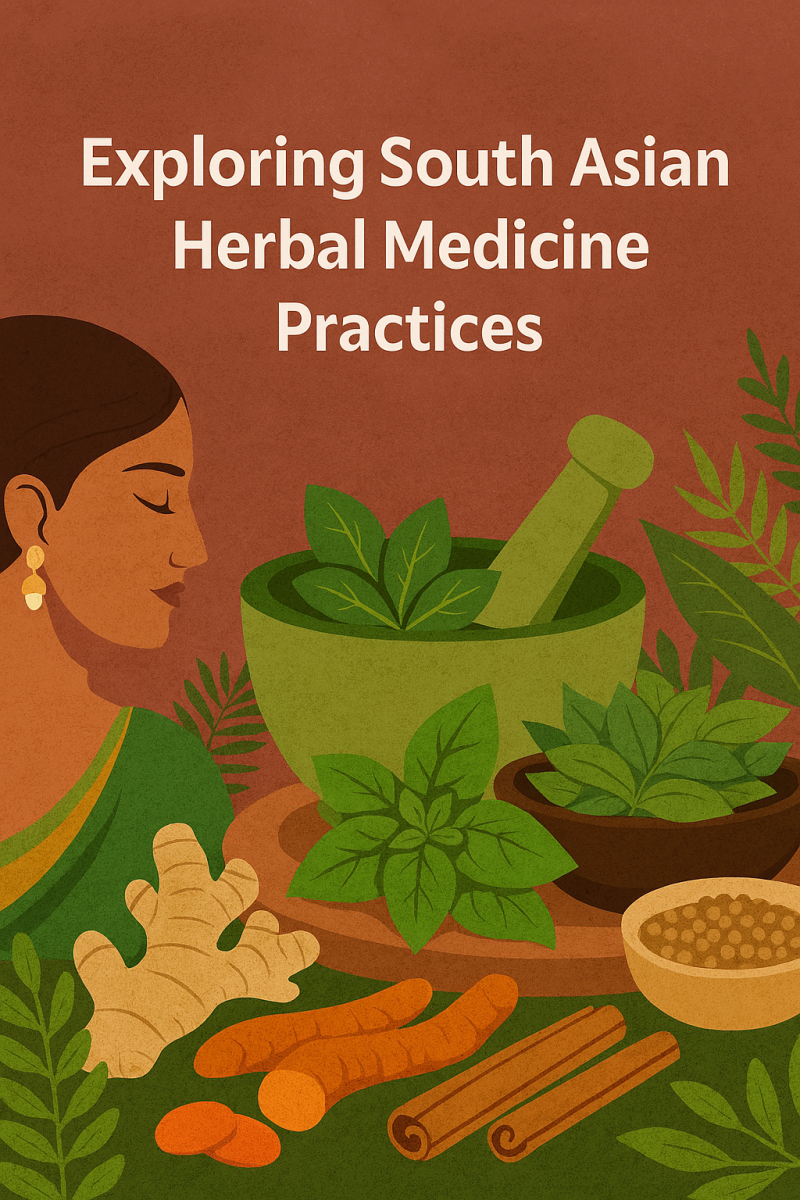
When people think of “herbal medicine,” many immediately picture Western health stores filled with neatly packaged teas and supplements. But the truth is that herbal healing has ancient roots, particularly in South Asia, where it has been practiced for thousands of years. From the mountains of Pakistan to the coastal plains of Sri Lanka, these remedies were born from the land, faith, and culture—and they remain vital to this day.
Herbal Medicine in Pakistan 🇵🇰
In Pakistan, herbal medicine is deeply tied to Unani Tibb, a traditional healing system that blends ancient Greek thought with Islamic medical knowledge and South Asian botanicals. Practitioners, known as hakims, rely on herbs, diet, and lifestyle adjustments to restore balance in the body.
Some common Pakistani herbal remedies include:
- Tulsi (Holy Basil): Used for colds, coughs, and boosting immunity.
- Ajwain (Carom seeds): Often brewed into teas for indigestion and stomach cramps.
- Neem leaves: Applied for skin conditions and infections due to their antibacterial properties.
- Turmeric: A household staple for inflammation, wound healing, and immunity.
Even today, Pakistani families keep these remedies close at hand—passing them down through oral tradition, often from mothers and grandmothers.
Indian Ayurveda 🌸
In India, Ayurveda is perhaps the most well-known system of herbal healing. It emphasizes balance between the body’s energies (doshas) and uses herbs like ashwagandha, brahmi, and triphala to restore health. Ayurveda also teaches that food itself is medicine, meaning what you eat daily matters as much as any prescribed herb.
Sri Lankan Deshiya Chikitsa 🌿
Sri Lanka has its own unique system, Deshiya Chikitsa, which predates Ayurveda but often works alongside it. This system relies heavily on native plants like gotu kola (for memory and digestion), coriander seeds (for fevers and colds), and cinnamon (native to Sri Lanka, used for digestion and circulation). Families often brew herbal teas at home, and even in modern hospitals, Ayurvedic wings exist side by side with Western medicine.
Lesser-Known South Asian Traditions ✨
While India and Pakistan often dominate the conversation, other South Asian countries also have rich herbal traditions:
- Nepal: Known for Himalayan herbs like jatamansi (for stress) and rhododendron (for heart health).
- Bhutan: Integrates Tibetan medicine with local plants, focusing on both physical and spiritual balance.
- Bangladesh: Uses folk herbalists (kabiraj) who specialize in rural remedies, often centered around turmeric, ginger, and mustard.
- Maldives: Traditional healers called hakeem use herbs mixed with coconut-based preparations for digestive and skin issues.
Why This Matters Today
It’s easy to see herbal medicine as “alternative,” but in reality, it was the original medicine—the first toolkit humanity ever had. Western science is only now catching up to what these cultures knew for centuries: plants hold immense healing power. Yet, as these practices get commercialized, the cultural origins are often ignored. Honoring their roots means respecting the communities that nurtured this knowledge.
Final Thoughts 🌿
For me, this is personal. My father is from Sialkot, Pakistan 🇵🇰, and the herbal traditions I write about aren’t abstract—they’re part of the wisdom of my own ancestry. Exploring these practices is a way of honoring that heritage while keeping the stories alive for future generations. In a world where wellness is often commodified, remembering where it all began matters.
Add comment
Comments
As a nurse for over 20 years, I’ve seen firsthand how modern medicine and traditional practices can complement each other. In Sri Lanka, Deshiya Chikitsa holds a special place in our healing culture. It’s different from Ayurveda in that it’s often more localized, with remedies passed down within families and communities.
When I was growing up, many households kept their own small collections of herbs for everyday remedies—things for digestion, coughs, or skin conditions. Even as a medical professional, I still recognize the wisdom in those practices. They’re not meant to replace clinical care, but they carry generations of knowledge that can support well-being in meaningful ways.
What I admire most about Deshiya Chikitsa is that it doesn’t separate the physical from the spiritual or the emotional. Healing is seen as holistic, involving plants, food, and sometimes even ritual. It’s a reminder that health is not just about treating disease, but about maintaining balance in life.
Anita, thank you so much for sharing this! I love how you explained the balance between modern medicine and Deshiya Chikitsa—it really shows the wisdom of combining both approaches. I’m curious, are there any specific herbs or remedies from your childhood that you still use or recommend today? I think readers would really enjoy learning about those everyday practices.
Yes, absolutely. One herb my paati always used for sore throats was coriander seeds. She would boil them into a warm tea, sometimes with a bit of ginger and honey. It soothed the throat and gave a calming warmth. Even today, I still turn to that simple remedy when I feel the first signs of irritation.
This was fascinating! I’ve mostly relied on Western medicine, but learning about herbal practices from Pakistan, India, and Sri Lanka really opened my eyes. I love that these traditions are still alive and connected to families and culture.
Thank you, Daniel! I’m glad you found it interesting. It’s amazing how these traditions are still practiced and passed down through generations. Exploring them reminds us that healing is about more than just medicine—it’s also about culture and community.